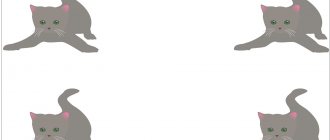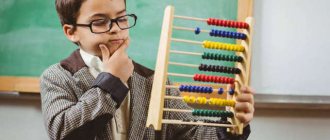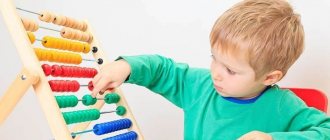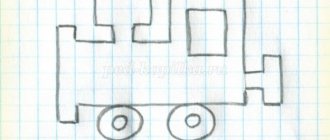What are math puzzles?
These are entertaining tasks with game elements. Such tasks do not require deep mathematical knowledge and special training; rather, you will need intelligence and observation.
There are a lot of math puzzles. These include logical puzzles, problems with numbers and pictures, paradoxes and probabilities, and much more. They can be simple, which the child can easily cope with on his own, or complex, when he needs the help of his parents.
Development and education of children from 2 to 11 years old in a playful way
Start practicing right now
Start practicing
Math problems counting up to 20
Task one
Lena had 4 candies, and Olya had 2 candies. How many candies did the girls have?
Left-click on the picture to enlarge it and download it in higher quality.

Math problems for preschoolers
Task two
Sasha made 2 Christmas trees, and Slava 4. How many Christmas trees did the guys make in total?

Task three
There were 5 roses in the vase. Mom cut 2 more. How many roses were in the vase?

Math problems for children 6-7 years old with pictures
Problem four
Petya collected 5 mushrooms, and Masha collected 4 mushrooms. How many mushrooms did the children collect?

Math problems for preschoolers
Task five
There were 4 yellow mugs and 2 purple ones on the table. How many mugs were on the table?

Math problems for preschoolers 6-7 years old
Problem six
2 girls played on the playground, and later 4 more boys came. How many children are there on the playground?

Math problems for children 6-7 years old with pictures
Problem seven
We bought 5 books for the library, and then 3 more books. How many books did you buy for the library?

Math problems for preschoolers
Problem eight
The cat had 5 kittens, 2 kittens were given away. How many kittens does the cat have left?

Math problems for preschoolers 6-7 years old
Problem nine
Anton had 9 cars, he gave 2 cars to a friend. How many cars does Anton have left?

Math problems for children 6-7 years old with pictures
Problem ten
Anya had 5 apples, she gave Olya 2 apples. How many apples does Anya have left?

Math problems for children 6-7 years old with pictures
Problem eleven
Seryozha had a dog, she gave birth to 3 puppies. How many dogs does Seryozha have?

Math problems for preschoolers
Problem twelve
10 balls were brought to the store, the children bought 2 balls. How many balls are left in the store?

Math problems for preschoolers 6-7 years old
Problem thirteen
There were 15 apples in the vase, 6 apples were eaten. How many apples are left in the vase?

Math problems for children 6-7 years old with pictures
Problem fourteen
There were 8 balls on the playground, then we bought 6 more balls. How many balls are there on the playground?

Math problems for children 6-7 years old
Problem fifteen
Roma had 4 red fish, 5 blue fish and 3 yellow fish in his aquarium. How many fish were there in the aquarium?
Problem sixteen
Misha had 20 cubes, he gave 7 cubes to Roma, and 6 cubes to Yura. How many cubes does Misha have left?
Problem seventeen
Vera had 9 dolls, she was given 4 more dolls. How many dolls does Vera have?
Problem eighteen
There were 18 tomatoes growing on the bush. 10 tomatoes are ripe. How many tomatoes are not ripe yet?
Problem nineteen
There were 4 cucumbers, 8 tomatoes, 3 carrots on the table. How many vegetables were on the table?
Problem twenty
The first class made 8 flags, the second class made 9 flags. How many flags did the children make?
LOGICAL PROBLEMS AND EXERCISES AS A MEANS OF DEVELOPING THINKING OPERATIONS IN SENIOR PRESCHOOL CHILDREN
author: Shomina Marina Anatolyevna
Teacher at the Children's Educational Institution "Kindergarten No. 28", Nizhny Novgorod
LOGICAL PROBLEMS AND EXERCISES AS A MEANS OF DEVELOPING THINKING OPERATIONS IN SENIOR PRESCHOOL CHILDREN
LOGICAL PROBLEMS AND EXERCISES AS A MEANS OF DEVELOPING THINKING OPERATIONS
IN SENIOR PRESCHOOL CHILDREN
Increased requirements for the intellectual readiness of preschool children for schooling actualize the need to develop innovative approaches to the development of the cognitive sphere of preschool children.
One of the aspects of this issue is issues related to optimizing the process of development of children’s mental activity. Since it is mental operations that are the main tool for a person’s cognition of the surrounding reality throughout his active life.
Moreover, the development of mental processes and operations, mental activity and, especially, creative thinking, is considered by scientists (L.A. Venger, N.N. Poddyakov, D.B. Elkonin, etc.) as the most important factor determining the comprehensive development personality.
The development of thinking in preschool age represents a special form of work that the child masters. This is mental, complex and interesting work. It is no coincidence that modern pedagogical requirements for a child’s mental activity consist in developing his skills to choose and carry out activities using search (research) actions, correlate actions with the result, strive for the final goal based on prediction, objectively evaluate the result, comparing it with his own attitude ( target).
One of the powerful factors in the intellectual development of a child, the formation of his intellectual, cognitive, thinking and creative abilities is mathematics.
In numerous psychological and pedagogical studies, both purely theoretical and applied (works by L.A. Venger, P.Ya. Galperin, L.S. Georgiev, A.M. Leushina, A.I. Markushevich, E.V. Proskura, D.B. Elkonina, etc.) the capabilities of preschool children in the field of mastering new mathematical concepts are being studied, new teaching methods are being developed, developing their concepts of set and number, familiarizing them with quantities and measurement, spatial relationships, time representations and etc.
In their works, scientists objectively prove that mastering mathematical content has an effective impact on the mental development of children. At the same time, an analysis of the practice of working with preschool children on the formation of elementary mathematical concepts indicates that the developmental influence of the content of specially organized activities in the form of classes is not always skillfully and rationally implemented in real work with children.
The experimental study we conducted showed a rather low level of mental activity of children in the classroom, which, in our opinion, can be explained by the fact that educators, when organizing work with children, are mainly focused (and limited) to communicating knowledge and information of mathematical content. At the same time, teachers are mainly focused on the use of traditional methods and techniques of working with children and practically do not use problem-based gaming technologies in their activities, in the implementation of which, as has been convincingly proven by the results of recent research in the field of preschool and general didactics, the child is not limited in searching for practical actions, experimentation, communication about the progress of the situation, resolving contradictions and mistakes, showing joy and grief and other intellectual emotions.
Based on our analysis of psychological and pedagogical research concerning the development of the mental subjectivity of preschool children, we consider entertaining material with mathematical content as one of the optimal means used in the implementation of problem-game technology for the logical and mathematical development of preschool children.
The purpose of our experimental study was to study the characteristics of the development of mental operations in children of senior preschool age in the process of using logical problems and exercises.
The following tasks are focused on the implementation of the above stated goal: tasks of working with children:
- To identify the current level of development of mental operations in children of senior preschool age.
- To develop a program for the development of mental operations in older preschoolers through the use of logical tasks and exercises.
- To study the effectiveness of the influence of the developed program on the development of thought processes in children of senior preschool age.
Experimental work was carried out in the senior group of MDOU No. 467 of the Sormovsky district of Nizhny Novgorod.
20 children aged 5-6 years took part in the experiment.
The first stage of our experimental work was the selection of methods and techniques aimed at studying the level of development of mental operations in children of senior preschool age.
Taking into account the age characteristics and capabilities of the cognitive sphere of children of senior preschool age, namely: a change in the nature of generalizations, a gradual transition from operating with external signs to the disclosure of objectively more significant features of an object, improving the skills of analysis and synthesis, developing the ability to understand and trace the cause-and-effect relationships of phenomena and the ability to build simple conclusions on their basis, as well as an increased tendency towards independence, independence and originality of thinking, we have determined with such methods and techniques:
- R.S. Nemov’s methodology “What’s superfluous here”;
- N.A. Bernshtein’s method “Sequence of Events”;
- 4 types of entertaining tasks: for transfiguration, for recreating a whole (plane figure) from parts, for discovering patterns when searching for a missing figure in a group, for identifying a sign of difference in two groups of figures.
The data obtained during the implementation of the experimental study allows us to state the following:
- 20% of children (4 people) have a fairly high level of development of mental operations. They independently complete tasks, acting at the level of practical orientation, and in some cases at the level of visual orientation. These children have a fairly well developed thinking operation such as generalization; they are able to find out the causes and consequences of the phenomena being studied, find similarities and differences, and “build” consistent conclusions. Children discover different ways to find solutions.
- The majority of children - 65% (13 people) are able to immediately accept the conditions of tasks and strive to complete them, while showing great interest in the results of their activities. At the same time, these children cannot independently find an adequate way to complete a task, often turn to an adult for help, find it difficult to draw consistent conclusions and experience difficulties in establishing connections between events. When solving a problematic problem, these children use both meaningful ways to solve the problem and actions through “trial and error.”
- In 15% of children (3 people), the level of development of mental operations is quite low. They are not guided in their actions by instructions, do not understand the purpose of the task, and therefore do not strive to complete it, are not ready to cooperate with an adult, and act inappropriately.
The data obtained during the implementation of the experimental study indicate an insufficient level of development of mental operations in the majority of children.
The second stage of our experimental activity was a formative experiment in line with the implementation of the objectives of which we developed a program focused on the development of thought processes in children of senior preschool age.
This program is a system of logical tasks and exercises in the form of games. Its main component is the child’s conscious search for a way to achieve a result based on his acceptance of the goal of the activity and independent reflection on upcoming practical actions leading to the result.
Solving entertaining problems presupposes some independence in children's search for them, which is due to the specifics of the material, so training in solving logical problems consisted only of teaching ways to analyze the conditions of the problem, of familiarizing children with the general analysis scheme. A child solving a logical problem must, based on his existing knowledge, skills, learned principles of solution, and the logic of sequential reasoning that are the result of an analysis of the condition, show ingenuity and ingenuity to finally find a solution.
When solving ingenuity problems, transfiguration tasks, tasks of recreating a whole from parts, the nature of the tests, which we noted in the ascertaining experiment, underwent significant changes under the influence of training: from practically effective tests, the child moved on to mental tests that preceded practical ones, from a large number practical tests proceeded to limit them due to the developing ability to look for a solution in the mind.
When recreating a figure based on a contour model, the mental search for a solution consisted in the tentative division of a sample figure, in thinking through the spatial arrangement of geometric figures and in a mentally created image. In the process of solving transfiguration problems, mental search consisted of testing different ways of removing or rearranging sticks, which was planned in advance on the basis of only a visual and mental analysis of the problem, and not practical tests.
In the process of finding solutions to problems of discovering patterns underlying the choice of a missing figure, and tasks of finding a sign of difference in two compared groups of figures, mental search consisted of independently first discovering properties common to all figures in the group, generalizing them and drawing conclusions on this basis, which made it easier to come to a decision.
During the training, we brought the children to the need for precisely this direction of analysis, which led to the correct decision. The very nature of the analysis in each specific case depended on the characteristics of the logical problem.
During the learning process, we developed in children the ability to search for solutions through imagined, rather than practically performed, tests. Mental tests in this case consisted of putting forward an assumption, a mental “move” in solving a problem, and a mental check of the correctness of the move. We taught children the ability to carry out a heuristic search for solutions to problems by using heuristic methods (limiting practical search actions, constructing hypotheses, making assumptions, using analogies, etc.).
The result of the search should be a guess for the solution, which, when solving elementary problems, is the finding, the “discovery” of the solution. The basis for the emergence of a guess is a thorough analysis of the problem.
In order to successfully implement the developed program, we optimized the subject-development environment in the group - we created a center for entertaining mathematics. In the center we placed logic games developed by A.A. Stolyar, various puzzles, board-printed games, didactic games and exercises, as well as the games “Tangram”, “Mongolian Game”, “Columbus Egg” and others. Children were provided with free access to gaming material. Along with replenishing the center for entertaining mathematics, we organized a plot-based logical and mathematical game “Zoo” (based on the plane modeling “Tangram”), aimed at showing older preschoolers independence in creating plane images, objects, and animals. In such a game, children were captivated by the goal - to create a silhouette image seen on a sample or independently conceived. Preschoolers took part in active practical activities with interest in order to create a silhouette image. In addition to this game, other game constructors were also used, such as “Pythagoras”, “Mongolian game”, “Vietnamese game”, “Columbus egg”, etc. Games of this type are interesting in content, entertaining in form, and are distinguished by their unusual, paradoxical results , designed to show activity and interest.
In our work, we also used Dienesh’s logical blocks, which allow us to model important concepts not only in mathematics, but also in computer science: algorithms, information coding, logical operations; construct statements with conjunctions “and”, “or”, the particle “not”, etc. Such games help accelerate the process of development in preschoolers of the simplest logical structures of thinking and mathematical concepts. With the help of these games, children successfully master the basics of mathematics and computer science in the future.
We also introduced elements of an entertaining nature into specially organized activities in the form of mathematics classes. This contributed to the expression of interest among preschoolers, they were happy to join in the search for solutions.
In our opinion, significant during the implementation of the developed experimental program was the modification of activities with children.
When organizing the educational process, we adhered to the following principles:
- lack of coercion;
- development of game dynamics (from small to large successes);
- supporting the playful atmosphere and real feelings of children;
- the relationship between gaming and non-gaming activities;
- transition from the simplest forms and methods of carrying out gaming activities to complex ones.
In order to study the effectiveness of the implementation of the developed program, we re-diagnosed the level of development of mental operations in children.
The results we obtained showed positive dynamics in the level of development of mental operations in children:
- the number of children with a high level of development of mental operations increased - 45% (9 people) and, accordingly, the number of children with a low level of development of the studied mental formation decreased - 5% (1 person);
- in the majority of children - 65% (13 people) the qualitative features of the course of various mental operations have changed, as evidenced by their ability to identify the essential features of objects, generalize, classify them on the basis of the identified features, correlate parts and the whole, establish patterns of constructing a series, differentiate an essential feature from the unimportant.
Thus, our experimental study confirms the possibility and necessity of using logical tasks and exercises as a means of developing mental operations in children of senior preschool age.
LOGICAL PROBLEMS AND EXERCISES AS A MEANS OF DEVELOPING THINKING OPERATIONS IN SENIOR PRESCHOOL CHILDREN




